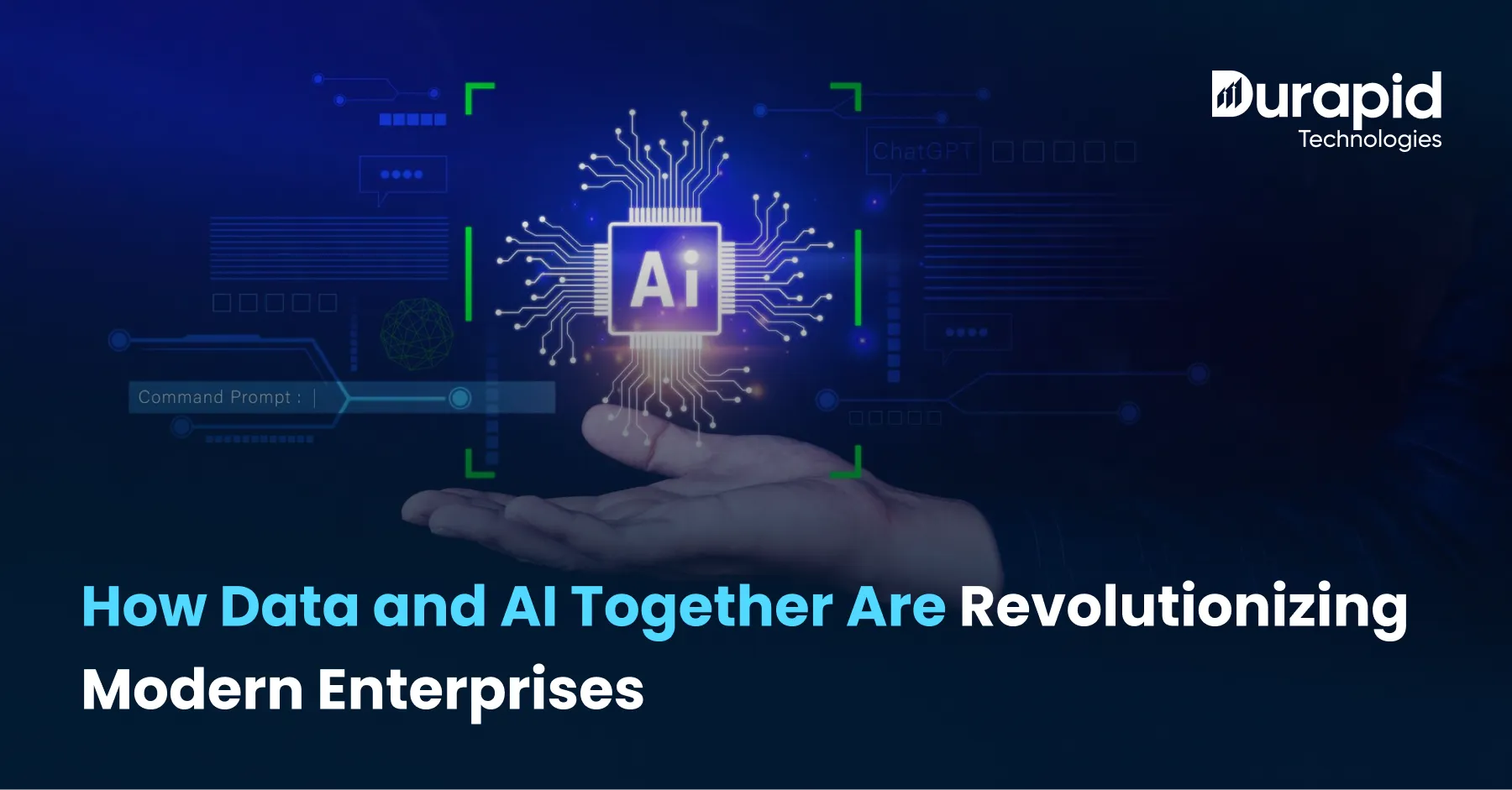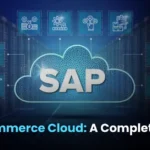How Data and AI Together Are Revolutionizing Modern Enterprises

Introduction: The Enterprise’s Silent Game-Changer
You know that feeling when your to-do list spills into tomorrow—and you’re convinced the whole week has gone sideways? Now imagine that at enterprise scale.
Thousands of processes. Terabytes of data. Millions of customer interactions.
And just one wrong integration? Boom. Productivity bottlenecks.
That’s why CIOs, CTOs, and decision makers today keep coming back to the same question:
How do we make our enterprise data work harder, faster, and smarter?
The answer hiding in plain sight: Data and AI.
Individually, they’re powerful. Together? They’re revolutionary.
But here’s the catch, most enterprises think they’re using Data + AI, while in reality, they’re just scratching the surface.
This blog is your field guide to enterprise AI transformation. We’ll talk about why a modern data platform, powered by AI-powered analytics and cloud data engineering, is setting the new benchmark for success. We’ll also go into the gritty details: technical stacks, governance, common pitfalls, and how to build a data and AI strategy for enterprises that actually scales.
Let’s dive in.
Why Data and AI Together, Not Separately
Think about data alone. It’s like an endless bookshelf in your office – powerful, but dusty without use.
Now think of AI alone. Super smart, but without good inputs? It’s like answering an exam with no question paper.
This is exactly why Data and AI must work hand-in-hand.
- Data → the raw material. Think customer journeys, IoT signals, transaction ledgers, HR records, social chatter.
- AI → the brain on top. Natural Language Processing, predictive modeling, anomaly detection, generative agents.
Together, they:
- Convert fragmented insights into enterprise intelligence
- Help transition legacy setups into a modern data platform
- Deliver real-time efficiency, at scale
- Unlock exponential innovation across industries
Still feel abstract? Let’s get practical.
The Big Shift – From Data Lakes to AI-Powered Decision Platforms
Enterprises used to be obsessed with data lakes. Collect everything. Store endlessly.
But the problem?
A swamp is a swamp, even if it’s digital.
Today, organizations are building data lakehouses and cloud-native architectures that integrate AI from the ground up. Instead of passive storage, they’re becoming action systems.
Technical Stack of a Modern Data + AI Platform:

Ingestion Layer
- Connectors for ERP, CRM, IoT sensors, logs
- ETL/ELT pipelines (Azure Data Factory / Databricks)
Storage Layer: Modern Data Platform
- Data lakes (raw zone), warehouses (curated zone), lakehouse (unified zone)
- Cloud-native (Azure Data Lake Storage) with elastic scale
Processing Layer
- Distributed compute frameworks (Apache Spark, Azure Synapse)
- ML model pipelines (Azure ML, TensorFlow, PyTorch)
AI Services
- AI-powered analytics dashboards (Power BI + embedded ML)
- Cognitive services (speech, vision, NLU via Microsoft Azure AI)
Governance
- Data governance + responsible AI governance policies
- Metadata catalogs + lineage tracking
Learn more about Durapid’s Data Engineering Services and how we architect these platforms for enterprise readiness.
Data no longer “sleeps” in lakes. It predicts, prescribes, and acts through AI.
Enterprise AI Transformation in Action
Okay, this is where most blogs play it safe. Not today.
Let me paint you a scenario.
Imagine a global retail enterprise. They run thousands of stores worldwide, both online and offline. Their challenge? Inventory chaos.
Old approach: Bulk stockpiles. Poor demand forecasting. Cash piles stuck in unused stock.
New approach with Data + AI:
- Real-time POS and online data streams feed into a central cloud data engineering pipeline.
- AI-powered analytics models predict regional demand with 85–90% accuracy.
- Logistic optimization applies ML to reduce fuel + transport costs by 15%.
End result?
✔ Lower wastage
✔ Higher revenue
✔ CX boosted by “always-in-stock” experiences
Here’s the kicker, none of this was possible with just data. AI interprets demand. AI prescribes logistics routing. AI nudges managers with timely insights.
That’s enterprise AI transformation in the wild.
For more industry-grade design thinking, explore Durapid’s Enterprise Transformation Offerings.
Challenges Enterprises Face (and How to Fix Them)
Sounds great, right? Except reality bites. Enterprises hit roadblocks.
Common Pitfalls:
- Data locked in silos: Legacy ERPs, scattered CRMs → unusable without integration
- Unclear governance → biased AI: Garbage in, garbage out. Without strong data governance and responsible AI governance, risk magnifies.
- Scaling beyond pilots: 80% of AI projects stall at PoC stage. Lack of cross-cloud architecture = limited ROI.
- Compliance chaos: With GDPR, CCPA, and regional data residency laws, you need compliance baked into the architecture.
Fixes (Best Practices for Scaling Data and AI in the Cloud):
- Adopt hybrid cloud architectures. Example: Microsoft Azure AI services scale globally while ensuring local compliance.
- Establish governance-first design. Embed audit trails, fairness checks, explainable AI dashboards.
- Automate your data pipelines. Automation reduces errors, improves quality, and accelerates go-live.
- Invest in change management. AI isn’t just tech. It’s people. Train accordingly.
PwC notes that AI will contribute $15.7 trillion to the global economy by 2030—but only if enterprises overcome these blockers.
Building Your Data + AI Strategy
If you’re an enterprise today, here’s how to build a data and AI strategy for enterprises that doesn’t collapse under its own ambition.
1. Start Small But Relevant
- Pick 1–2 use cases that impact business outcomes: fraud detection, supply chain optimization, customer churn.
2. Invest in a Modern Data Platform
- Without one, scaling AI means band-aid fixes.
- Learn more in Durapid’s Cloud Services.
3. Align AI to Business KPIs
- Forget vanity experiments. Ask: Will this AI model reduce cost? Improve CX? Boost compliance?
4. Prioritize Responsible AI Governance
- Algorithmic bias headlines kill trust faster than data breaches. Build policies now.
- Reference: World Economic Forum on Responsible AI.
5. Keep Iterating
- A strategy isn’t static. Audit quarterly. Scale what works, kill what doesn’t.
Technical Case Breakdown – Cloud Data Engineering for Enterprises
Remember, enterprises = scale.
Here’s the tech anatomy of a successful cloud-scale rollout:
- Data lakehouse on Azure → Combine structured + unstructured data
- ModelOps pipeline → Streamline ML lifecycle, auto retraining on drift detection
- Data Governance layer → Integration with Purview for metadata, RBAC for access control
- AI-powered analytics dashboards → Embedded into CRM/ERP systems (e.g., Dynamics)
- Automation → CI/CD pipelines + Infrastructure as Code (IaC) via Terraform
Read how Durapid simplifies Cloud Data Engineering.
This isn’t future-gazing. It’s what’s rolling out across BFSI, Healthcare, Manufacturing, and Retail today.
The Future of Data and AI in Enterprises
Here’s the bit that excites me the most.
In the next 3–5 years, we’ll see:
- GenAI fused with enterprise data → Imagine copilots for every employee, making workflows twice as fast.
- Autonomous decisioning → AI systems making enterprise-grade operational choices within governed risk.
- Self-healing platforms → Auto-detect, auto-correct pipelines without downtime.
- Industry clouds → Packaged, vertical-specific AI + data templates for BFSI, Retail, Manufacturing.
And it won’t be optional.
As Gartner says, by 2026, 75% of enterprises will operationalize AI, up from fewer than 10% today.
Those who ignore this wave? They’re not just behind. They’re invisible.
FAQ Section
Q1: How to build a data and AI strategy for enterprises that actually scales?
Start by aligning AI projects to business outcomes. Build on a modern data platform to ensure scalability. Prioritize governance and compliance early, and pilot small before enterprise-wide rollout.
Q2: What are the benefits of integrating AI with a modern data platform?
You move from reactive BI to AI-powered analytics. Benefits include real-time decisioning, automated anomaly detection, reduced operational risk, and more accurate forecasting.
Q3: What are best practices for scaling data and AI in the cloud?
Adopt cloud data engineering patterns like automation, hybrid deployment, and governance-first design. Use monitoring frameworks for model drift, and invest in employee upskilling around analytics adoption.
Q4: How does responsible AI governance influence ROI?
It’s the make-or-break. Organizations without responsible AI governance often face customer mistrust, compliance penalties, and reputational risks that wipe away financial gains.
Q5: Which tools or platforms lead in enterprise AI transformation today?
While many exist, Microsoft Azure AI leads in enterprise adoption because of its scalability, compliance features, and prebuilt toolkits. Integrations with data lakehouse + analytics make implementation seamless.
Conclusion: The Data and AI Imperative
To wrap this up
We’ve been saying “data is the new oil” for over a decade. But oil on its own doesn’t move the world. Engines do. AI is that engine.
When enterprises marry data and AI, they don’t just innovate. They redefine themselves. From reactive to proactive. From scattered silos to enterprise AI transformation.
Whether it’s building modern data platforms, enabling cloud data engineering, or embedding AI-powered analytics, the shift is already here. The only question is—will you ride it now, or catch up later?
For enterprises that choose the first option, success is no longer about internal efficiency. It’s about relevance itself.
At Durapid, we help enterprises simplify, scale, and accelerate with Data and AI strategies built for tomorrow. Start a free consultation with our experts today.
CTA
Ready to unlock enterprise-scale transformation with Data and AI? Start a free consultation with Durapid. Our architects, engineers, and AI specialists partner with you to build platforms that are modern, scalable, and future-proof.





